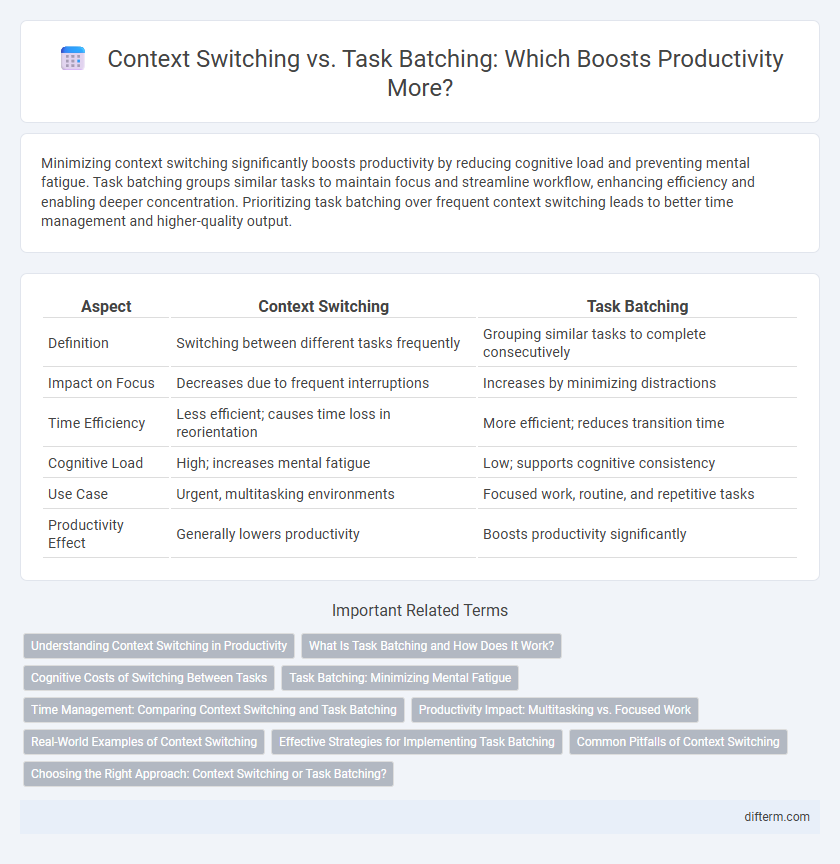Minimizing context switching significantly boosts productivity by reducing cognitive load and preventing mental fatigue. Task batching groups similar tasks to maintain focus and streamline workflow, enhancing efficiency and enabling deeper concentration. Prioritizing task batching over frequent context switching leads to better time management and higher-quality output.
Table of Comparison
| Aspect | Context Switching | Task Batching |
|---|---|---|
| Definition | Switching between different tasks frequently | Grouping similar tasks to complete consecutively |
| Impact on Focus | Decreases due to frequent interruptions | Increases by minimizing distractions |
| Time Efficiency | Less efficient; causes time loss in reorientation | More efficient; reduces transition time |
| Cognitive Load | High; increases mental fatigue | Low; supports cognitive consistency |
| Use Case | Urgent, multitasking environments | Focused work, routine, and repetitive tasks |
| Productivity Effect | Generally lowers productivity | Boosts productivity significantly |
Understanding Context Switching in Productivity
Context switching interrupts focus by forcing the brain to shift attention between different tasks, leading to decreased efficiency and increased cognitive load. Studies show that frequent context switching can reduce productivity by up to 40%, as it impairs working memory and increases error rates. Task batching minimizes these disruptions by grouping similar activities, allowing sustained concentration and better resource allocation for complex projects.
What Is Task Batching and How Does It Work?
Task batching is a productivity technique where similar tasks are grouped together and completed in dedicated time blocks to minimize disruptions and cognitive load. By focusing on related activities consecutively, task batching reduces the mental effort required to switch contexts, leading to enhanced concentration and efficiency. This method leverages the brain's ability to stay deeply engaged with one type of task, boosting overall output and reducing time lost to context switching.
Cognitive Costs of Switching Between Tasks
Frequent context switching significantly increases cognitive costs by forcing the brain to repeatedly reset its focus and recall task-specific information, leading to reduced efficiency and higher mental fatigue. Task batching minimizes these cognitive disruptions by grouping similar tasks together, enabling deeper concentration and smoother mental transitions. Studies show that minimizing task switches can improve productivity by up to 40% due to lower cognitive load and better resource allocation in the brain.
Task Batching: Minimizing Mental Fatigue
Task batching enhances productivity by grouping similar activities to reduce mental fatigue and preserve cognitive energy. This method limits the number of context switches, which are known to deplete focus and increase completion time for tasks. Studies show that batching tasks like emails, meetings, or creative work can boost efficiency by up to 40%, helping maintain sustained attention and improving overall output quality.
Time Management: Comparing Context Switching and Task Batching
Context switching significantly reduces productivity by causing cognitive load and increasing time spent reorienting to new tasks, often resulting in up to a 40% loss in effective work time. Task batching groups similar activities together, minimizing distractions and improving focus, which can enhance time management efficiency by as much as 30%. Implementing task batching over context switching leverages the brain's ability to maintain flow, leading to better prioritization and faster task completion.
Productivity Impact: Multitasking vs. Focused Work
Context switching significantly reduces productivity by increasing cognitive load and causing time loss due to the brain's need to refocus on new tasks. Task batching groups similar tasks together, minimizing interruptions and enhancing deep work, which leads to higher efficiency and better output quality. Studies show that focused work without frequent context changes can improve productivity by up to 40%, compared to multitasking that divides attention and impairs performance.
Real-World Examples of Context Switching
Context switching significantly reduces productivity by increasing cognitive load, as shown in a Microsoft study revealing workers lose an average of 23 minutes each time they switch tasks. In real-world office settings, employees interrupted by emails or meetings frequently experience fragmented focus, leading to errors and longer project completion times. Software developers often see a 40% drop in efficiency when handling multiple codebases simultaneously, highlighting the costly impact of context switching on performance.
Effective Strategies for Implementing Task Batching
Task batching enhances productivity by grouping similar tasks to minimize context switching, which often leads to cognitive fatigue and reduced focus. Effective strategies for implementing task batching include scheduling dedicated time blocks, using time-tracking tools to monitor efficiency, and prioritizing tasks with comparable cognitive demands. Adopting these methods can streamline workflows, improve concentration, and increase overall work output.
Common Pitfalls of Context Switching
Context switching often leads to significant productivity losses due to the cognitive load required to reorient attention between tasks. Frequent interruptions cause increased reaction times and reduced concentration, resulting in higher error rates and longer completion times. Task batching minimizes these pitfalls by grouping similar tasks, which enhances focus and streamlines workflow efficiency.
Choosing the Right Approach: Context Switching or Task Batching?
Choosing the right approach between context switching and task batching depends on the nature of the work and cognitive load involved. Task batching minimizes mental fatigue and enhances focus by grouping similar tasks, leading to increased productivity and reduced errors. In contrast, context switching can disrupt workflow and increase completion time, but may be necessary for urgent or varied tasks requiring immediate attention.
Context switching vs Task batching Infographic

 difterm.com
difterm.com